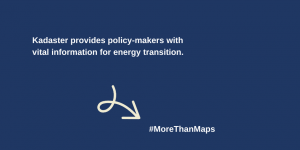Land Registry and Mapping Agency The Netherlands
“The transitional change to a sustainable energy system is perhaps the most challenging policy goal of our time. It requires not only an industrial approach, but also a major effort of innovation in all related fields of expertise. In the past year, we have seen how geodata can contribute to an effective planning and concrete measures in the case of solar energy potential in the built-environment. In combination with administrative data, this provides the required realistic insights the policy makers need. With state of the art deep learning techniques, we are now able to update and monitor the transition related to the policy goals and projects where unused potential can be found. This is a telling example of how geodata is rapidly becoming an important factor in an effective approach to the greater obligations we are facing.”
Frank Tierolff, Chair Executive Board Cadastre, Land Registry and Mapping Agency The Netherlands
The Netherlands Cadastre, Land Registry and Mapping Agency (Kadaster) created a database of information related to solar potential, (available space on roof tops including detecting existing solar PV installations) which is very useful for the Regional Energy Strategy (RES) regions to reach their targets related to the Climate Agreement.
High resolution elevation data was used to create solar potential models and deep learning techniques were employed to detect existing solar panels from very high resolution aerial images for the whole of the Netherlands. Data pre-processing and post-processing were customised to achieve automation, high accuracies in the results and to be able to match them with building information. This is a good example of GeoAI, where the best of both the worlds is combined to help tackle large geographic datasets for energy transition.
Benefits
- Helps policy-makers to speed up the energy transition by providing? information on where and how much space is available to generate solar energy. At the same time, the data is easy to understand and visualise.
- Provides an insight on not only where the potential lies, but also categorises it by building and owner type, which is much more useful to the policy-makers.
- Provides information on locations of currently installed solar PV with high quality. This is especially useful to update the Production Installation Register which is largely, but not entirely complete, for small installations in homes and businesses.
- Deep learning algorithms enable fast and fairly easy updating of the solar installation database at regular intervals for the entire country.
- Presents a realistic insight on solar potential of building rooftops which is useful in urban planning applications.
- Many more possibilities are opened up by the development and testing of the solar potential models for rooftops, for example calculating solar potential for parking lots where solar panels could be placed on carports or on building facades.

